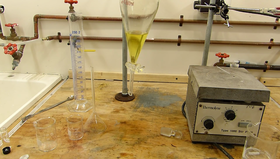Isopropyl nitrite
 Freshly prepared isopropyl nitrite
| |
| Names | |
|---|---|
| IUPAC name
2-Propyl nitrite
| |
| Other names
1-Methylethyl nitrite
Isopropyl alcohol nitrite Nitrous acid, isopropyl ester | |
| Properties | |
| C3H7NO2 (CH3)2CHONO | |
| Molar mass | 89.09 g/mol |
| Appearance | Straw yellow liquid |
| Odor | Sweet |
| Density | 0.8684 g/cm3 |
| Melting point | −132 °C (−206 °F; 141 K) [1] |
| Boiling point | 40 °C (104 °F; 313 K) |
| Insoluble | |
| Solubility | Miscible with acetone, diethyl ether, ethanol |
| Hazards | |
| Safety data sheet | Sigma-Aldrich |
| Flash point | -29 °C (-20.2 °F; 244 K) |
| Lethal dose or concentration (LD, LC): | |
| LD50 (Median dose)
|
300 mg/kg (mouse, oral) 3,200 mg/kg (rabbit, oral) 980 mg/kg (rat, oral)[2] |
| Related compounds | |
| Related compounds
|
Ethyl nitrite Isobutyl nitrite |
| Except where otherwise noted, data are given for materials in their standard state (at 25 °C [77 °F], 100 kPa). | |
| Infobox references | |
Isopropyl nitrite is a highly flammable organic ester. It has the general formula (CH3)2CHONO.
Contents
Properties
Chemical
Isopropyl nitrite reacts with hydrazine hydrate and sodium hydroxide to form sodium azide.
Physical
Isopropyl nitrite is straw yellow color and has a sweet, pleasant smell. It is immiscible and less dense than water. Isopropyl nitrite has a very high vapor pressure and a low boiling point, although it will decompose on boiling to produce nitrogen oxides and isopropanol. A low flash point combined with the high vapor pressure means it is very easy to ignite.
Availability
Isopropyl nitrite was available as the main active ingredient in some types of "poppers" (along with amyl nitrite), but it's harder to get hold of in recent years. In some countries, the sale of amyl nitrites may be be restricted or illegal.
It's better made in a home lab setting.
Preparation
Concentrated hydrochloric acid is slowly dripped onto sodium nitrite suspended in isopropanol, generating nitrous acid which reacts with the alcohol. The concentration of isopropanol should be less than 100% to ensure the solution does not get too acidic (which will rapidly decompose the ester) and that some of the precipitate byproducts dissolve. Diluted sulfuric acid can also be used but this will result in a larger amount of precipitate due to sodium sulfate's lower solubility compared to sodium chloride.[3][4]
Every reagent should be as cold as possible to limit decomposition to nitrogen oxides. An ice bath may be needed.
To limit exposure to this compound, the reaction is often conducted in a separatory funnel, which can be easily closed to limit vapors, and is also a convenient way of removing the aqueous layer.
Projects
- Make sodium azide
- Antidote for hydrogen sulfide and cyanide poisonings
Handling
Safety
As well as being highly flammable, being an organic nitrite it promotes vasodilation in the body, pushing more blood to the brain. Hence breathing fumes of isopropyl nitrite can have some mild strange side effects that mostly end up in a headache. Proper ventilation is required when using this compound.
In case of nitrite poisoning, small dosages of methylene blue are recommended (0.1 ml of 1% solution per kilogram of patient's weight, intravenously). Not to be confused with large dosages, which are toxic in the same way nitrites are, and are used to treat poisoning with blood agents like cyanides, carbon monoxide and hydrogen sulfide (isopropyl nitrite itself can work as an antidote in these cases).
Storage
Storage is best done in a cold place such as a fridge or freezer, but care must be taken to prevent as the vapors travel quickly and can easily find a source of ignition.
If care is taken to make sure the ester does not contain any acid before storage, it will not quickly decompose and may be stored cold for many months. Anhydrous calcium chloride is often added to keep the compound dry, as prolonged exposure to water may cause hydrolysis.
Disposal
Acid hydrolysis of the compound destroys it quickly, with the evolution of nitrogen oxides. It is recommended to either burn it or simply let it evaporate over pouring it down a sink, as its solvent properties may adversely affect a plumbing system.
References
- ↑ R. F. Grant and D. W. Davidson, J. Chem. Phys. 33, 1713 (1960), Dielectric Study of Some Liquid Alkyl Nitrites
- ↑ http://www.chemblink.com/MSDS/MSDSFiles/541-42-4_Clear%20Synth.pdf
- ↑ https://www.youtube.com/watch?v=bbmpmLjfkkM
- ↑ https://www.youtube.com/watch?v=ipqSn0nnZBU